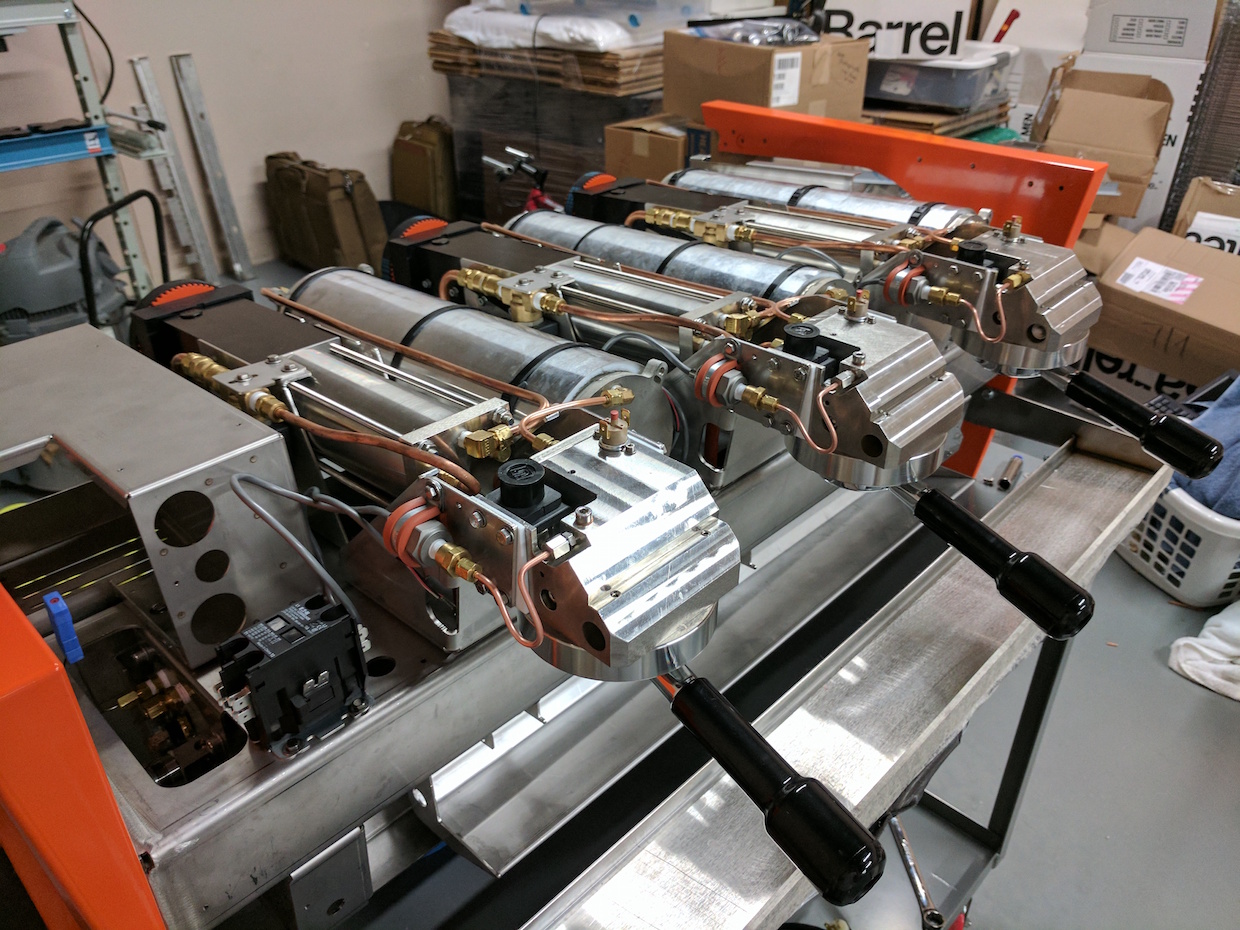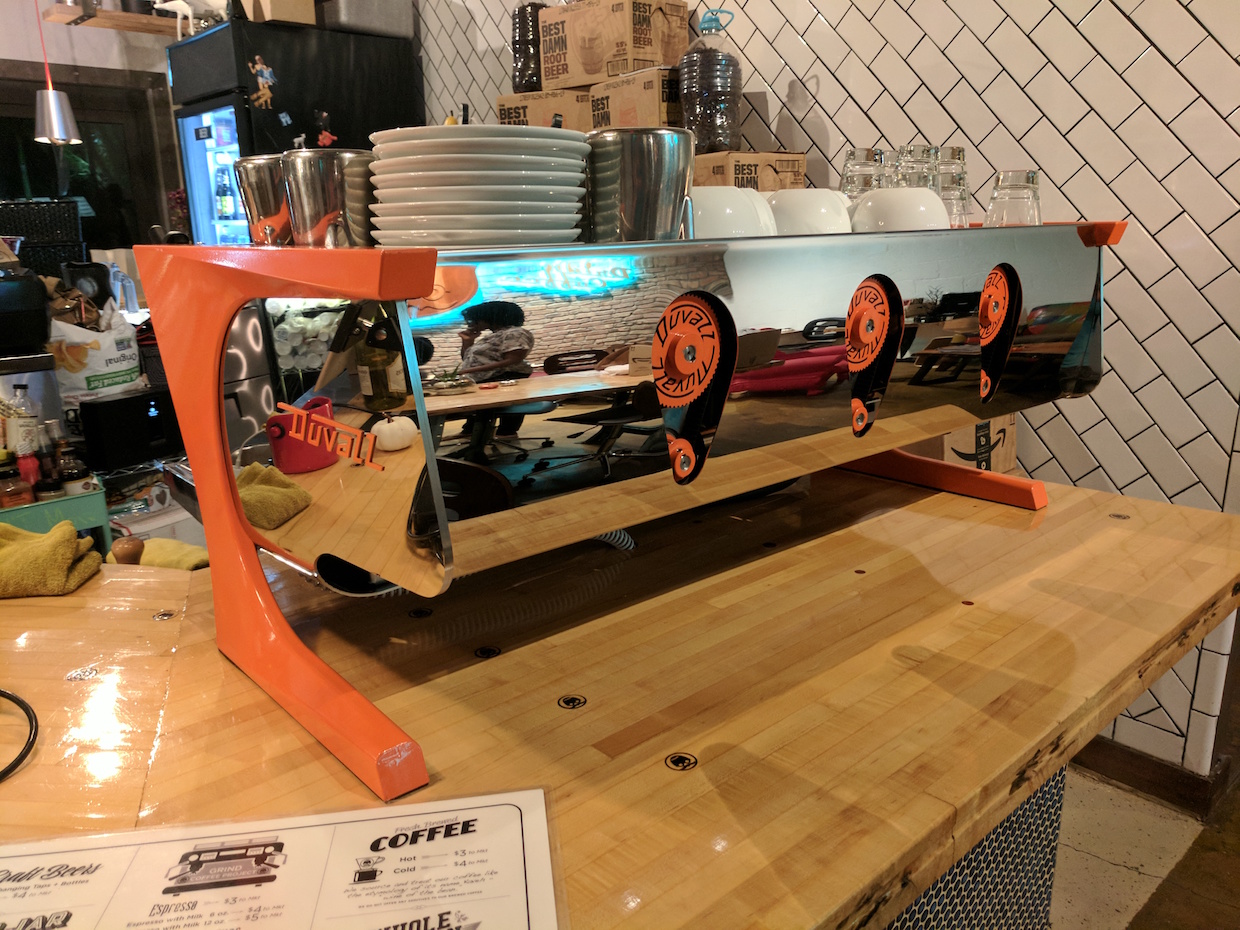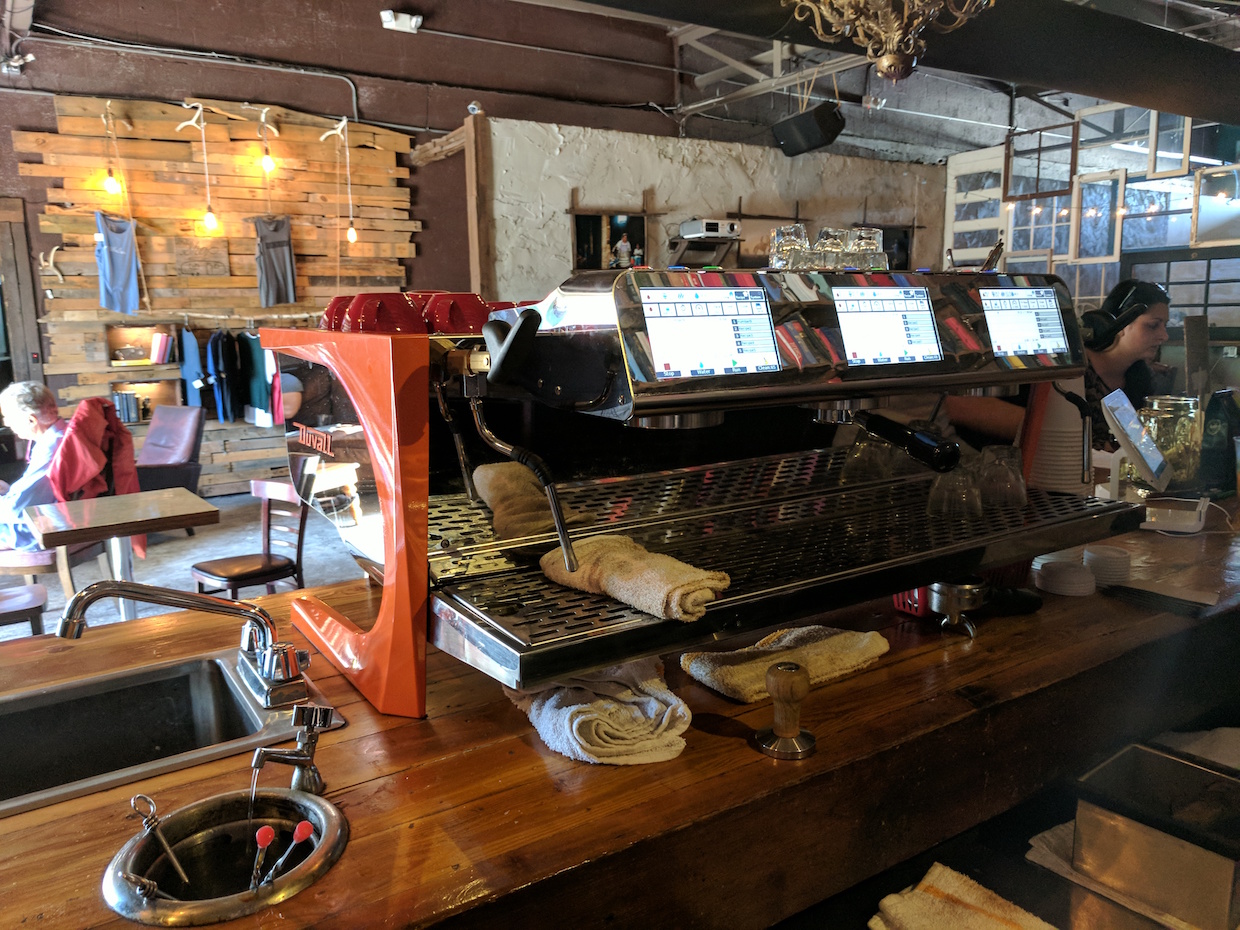As technical innovation in espresso machinery has been systematically moving from variable to variable in a quest for maximum control, the fundamental mechanics haven’t actually changed much.
Espresso machines continue to send water through coffee either by way of electric pumps or vertical pistons driven by manual levers, with various complicated interventions added in attempts to modulate one factor or another. In recent years, one of the most highly explored variables in espresso has been the rate of the flow of the water through the coffee.
With its forthcoming flagship machine called the FC-1, a new company called Duvall Espresso claims to have achieved an exceptionally precise control over flow rate, and it takes a dramatically different mechanical approach to reach that end.
Relying on neither a pump nor a lever, the FC-1 machine employs its own proprietary servo motor to drive a piston through a sealed horizontal column, like a syringe. Syringes are designed to hold specific volumes, and by pushing the stopper through at a certain rate, the user can easily determine both how quickly and how much fluid is flowing in real time. The FC-1 is engineered to do exactly the same thing, just on a larger, hotter scale.
“Hopefully this will be the last big innovation we need,” Duvall Espresso President Gideon Duvall told Daily Coffee News. “Honestly I feel like this is the way we should’ve been doing it the whole time. The only reason we haven’t been doing it is because the integrated circuit didn’t exist back when they started designing espresso machines. You have to have a computer to do this. You can’t do flow rate control technology with an on/off switch. In order to really do it correctly, you have to use the integrated processor, and then you have to say, ‘what’s really the best way of doing it?’ And you gotta think outside the box.”
An engineer by trade, Gideon Duvall came to coffee essentially through science while he was a student at Georgia Tech. The material science engineering student guzzled joe while studying at Octane Coffee in Atlanta, where conversations with staff lead to a project in developing a coffee machine that yielded a French press-like cup automatically while also being easy to clean. What resulted was a unique centrifugal brewing machine, the patents for which Duvall still holds.
With that concept essentially proven, the project was shelved as Duvall moved on to a variety of projects in the following years, including a selective sound-isolating “bionic ear”-like technology that was almost bought out by Google; a process for manufacturing carbon nanotubes, and consultations with Fender Guitars on developing a line of in-ear monitors for musicians.
Upon returning to coffee about eight years ago, Duvall found that the single-cup centrifuge machine was shaping up to be too expensive to build and at a time when the market for such a machine was too small. Yet as coffee still appeared to him as an industry ripe for innovation, his gears shifted into espresso instead.
“I originally saw coffee as a good market to get into from a business standpoint, because the technology hadn’t changed in like a thousand years,” said Duvall. “People were dropping twenty grand for these boxes of on/off switches. It was just incredibly basic; there would be no real advancement in the industry. When you come at the industry from a blank sheet of paper, with no history, no nostalgia, no supplier relationships you need to worry about ruining, I think you come at it from a more honest and analytical angle.”
Each saturated brew group on the FC-1 machine is backed by its own cylindrical 3-liter brew boiler, the thermal mass of which keeps temperatures stable without requiring a pre-heat phase that might diminish steam performance in a rush. Inside these boilers, servo-motor-driven ball screws move 63-millimeter diameter pistons at precise rates based on an algorithm.
“By controlling the movement of the piston in a sealed system, we know exactly how fast the water’s flowing,” said Duvall. “We can slow it down to incredibly slow and go drip by drip if we want, or we can go incredibly fast, instantaneously, while knowing exactly how fast we’re flowing without the error that you get with a flowmeter.”
Duvall said the system is almost completely silent apart from the sounds of solenoid valves activating and of water flowing through its pipes. Needle valves and other mechanical interventions are unnecessary in the FC-1 system, according to the company. By additionally removing the need for a flowmeter, Duvall said, the machine is more precise due to less lag.
“The big difference in why the piston-based system is so much better is that you don’t have the feedback loop that you would have to have with a flowmeter,” said Duvall. “What [machines with flowmeters] do is they flow a fluid, the fluid has to move, then the flowmeter has to sense the movement. Then that signal has to be sent to the computer, and the computer tries to adjust the pump pressure to try and achieve a different flow in the future. So they’re never real-time accurate, because the flow has to happen before it can be sensed and processed by the computer. There’s a time lag associated with all of that.”
Duvall’s patented “Smart-Pump” technology will reportedly deliver any flow rate from 0.01 cc/sec up to 30 cc/sec at any pressure from 0 up to 14 bars. The machine also tracks the total dispensed volume, up to a maximum dispensation of 14 fluid ounces per shot, or “coffee shot,” or tea, or other drink at the larger end of the volume range.
The machine’s pumps and pulleys are visible through the back of the case, allowing customers to witness part of what’s physically happening as their coffee is prepared. Duvall said these details will be customizable in terms of color, materials and branding.
Care was also taken in building what the company considers to be a straightforward, user-friendly interface through which users set shot parameters without having to input specific graduated steps of increasing or decreasing flow rates for each moment over the course of a brew cycle.
“That’s incredibly cumbersome to do,” Duvall said of other machines’ variable flow rate programming. “It doesn’t deliver on the promise of what flow rate control can really do. Your average user just wants to walk up to a machine and say, ‘I want a 30-second shot, 40 grams out.'”
The machine’s software uses algorithms to determine the flow rate based on user-designated parameters for volume over time. With each group outfitted with a heat-tolerant, no-frills 7-inch touchscreen Duvall said is built to last, users can also designate the trend in flow, choosing how steeply increasing, decreasing or constant they want it to be without altering the total volume or duration. The system calls this the shot’s “flow ramp.”
Pressure becomes relevant in determining the preinfusion. Users can input their desired target pressure for preinfusion and the rate of water flowed to achieve it, exercising real control over how the coffee puck is initially compressed and how fines migrate during the preinfusion phase, according to Duvall. From that point comes a user-designated dwell time, followed by the extraction phase over which the algorithm calculates the rate at which to send the remaining shot volume through coffee to finish in the designated time.
With easy access to precise control over preinfusion, dwell time, and the extraction flow ramp in addition to temperature, volume and duration, Duvall said users no longer need to stop dialing in a coffee when one acceptable cup is achieved. He suggested experimentation and recipe comparisons become more convenient and efficient.
“We’re delivering you a very precise piece of equipment that allows you to independently change the variables that directly affect flavor without having to go through undue levels of experimentation,” said Duvall. “It helps to remove the factors that don’t play as big a role in generating flavor.”
Pressure in an FC-1 is considered one of those factors, apart from its role in preinfusion. The system acknowledges pressure as a function of flow, dose and grind, but it is considered by Duvall to be generally inconsequential when it comes to flavor. The machine continues to graph the pressure as a reference point for baristas to monitor in relation to other variables, particularly grind size.
Duvall said the machine is at once revealing and forgiving of the inevitable slight drift in grind size, such as in a rush when the grinders get warm, burr plates expand and the grind drifts coarser.
“In a normal machine, you’d go from making 30-second shots to making 20-second shots that are under-extracted,” said Duvall. “With our technology, you’re still making 30-second shots. It might run at a little bit lower pressure, but your extraction percentage is pretty doggone close, and so your customer’s still getting a good product and they don’t know the difference.”
When the graphical display alerts the barista to the difference in pressure, assuming the dose and tamp remained consistent, the grind becomes the obvious culprit and she or he can adjust it in order to maintain the desired mouthfeel of the shop’s straight espresso. All the while, the flavor, according to Duvall, remains essentially consistent either way.
Other features of the interface include access to saved recipes, usage records and diagnostic info. Duvall said the system allows for roasters or coffee directors to communicate brewing parameters to staff, essentially guaranteeing a specific flavor achievement without relying on every barista’s palate or sensibility. Though wireless connectivity won’t be a feature at launch, the capability is built in and awaits future development.
Current pricing projections have a 3-group FC-1 likely costing around $25,000, according to the company. Two-group machines will land around $18,000 to $20,000, and a single group will be priced in the neighborhood of $15,000. Prototype machines have already toured the United States and appeared at a Duvall Espresso booth at the SCA Expo in Seattle earlier this year.
The machine is now undergoing a “production refresh,” said Duvall, involving upgrading components and fortifying systems prior to attaining certifications. Duvall said FC-1 demo units will be in the hands of one or two committed early-adopter coffee companies by the end of this year, and that by the 2019 SCA Expo in Boston, certified production machines should be ready for delivery to buyers.
Howard Bryman
Howard Bryman is the associate editor of Daily Coffee News by Roast Magazine. He is based in Portland, Oregon.













Comment